|
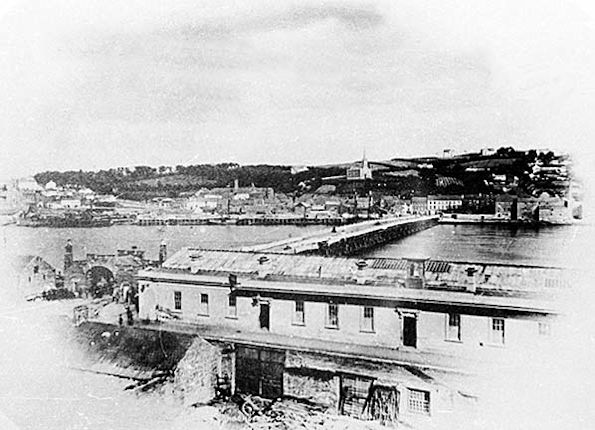
Londonderry Foyle Road station looking west in 1863. The original station dating from 1850 is seen in the foreground. Foyle Road is in front of the station building. The pitched roof that is at the rear of the building is the passenger station trainshed. To the left of the station is the entrance to the River Foyle bridge a wooden structure that had opened in 1790. The bridge can be seen spanning the River Foyle and providing a link to the Waterside district.
Londonderry Foyle Road 1850 to 1899
The walled city of Derry/Londonderry in the county of Londonderry, located on the western side of the River Foyle in the north of Ireland, was established in 1613 and by the mid-19th century it had become an important port and manufacturing centre. In the 1840s it was realised that railway connections would be essential if the city was to continue to prosper and in July 1845 the Londonderry & Enniskillen Railway (L&ER) company was authorised to build a line 59 miles long between the two centres after which it had been named. The line was built to what would become the Irish standard gauge of 5 foot 3 inch. From the start raising capital proved to be an issue and progress was slow. On 19 April 1847 the L&ER opened 14 miles of line between Londonderry (Gallows Strand) and Strabane. A service of four passenger trains in each direction was operated along the single track line.
It took until 18 April 1850 for the first permanent station at Foyle Road to be completed. The station was located at the west end of the Wooden Bridge (which was opened in 1790 and spanned the river making a connection with the Waterside district) on the west bank of the River Foyle, to the east of its namesake. An entrance building fronted onto what was then called Bridge Street and behind it there was a train shed that covered one platform and two lines. Between the train shed and the river there were a further pair of lines that were connected at their northern end by a turntable. A painting from 1863 by the artist J H Connor shows the train shed to have had a pitched roof and on its eastern side there was a canopy that protruded from it at the height of about one storey. Above the canopy there appear to be a row of windows which presumably allowed light to shine onto the platforms. A photo from 1863 shows that the Foyle Road (west) side of the station had a substantial stone built building roofed with slate. The building was only one storey high which suggests that the ground was higher on this side of the station in 1850 and therefore must have been supported by some form of retaining wall. Both the painting and the photograph show that the first Foyle Road station was more substantial than has often been described by secondary sources.
To the south of the passenger station on the east side of the line there was a single road engine shed, and the goods facilities were also located on the east side, further to the south. The goods facilities included two large and one smaller single road goods sheds (see 1848 map below).
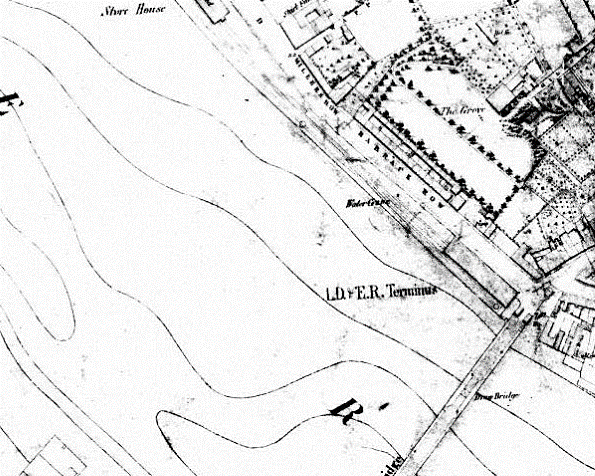
When the station at Foyle Road opened the L&ER line still only extended as far as Strabane and it took until 9 May 1852 for the first extension to be made to Newtownstewart. A few months later on 13 September 1852 the line opened to Omagh. In July 1853 a double line was opened between Omagh and Newtownstewart. This was the only double track part of the L&ER, and it would take until 19 August 1854 for Enniskillen to be reached by this railway.
On 29 December 1852 the Londonderry & Coleraine Railway (LCR) opened a station at Waterside almost directly opposite Foyle Road and adjacent to the Wooden Bridge.
The financial situation of the L&ER had not improved and when the Dundalk & Enniskillen Railway (D&ER) opened their line on 2 February 1859 (creating a through route between Derry/Londonderry and Dublin) discussions followed with regards to having the latter company operate the former company’s line. On 1 January 1860 the L&ER leased their line to the D&ER for 99 years.
Once the D&ER had taken over the operation of the L&ER through services were introduced between Derry/Londonderry and Dublin for the first time as this was the first physical connection between the L&ER and any other Irish railway.
The Portadown, Dungannon & Omagh Railway completed their line (with the opening of the Dungannon – Omagh section) on 2 September 1861 which created a through route between Derry/Londonderry and Belfast (via Portadown). This route (Derry/Londonderry–Omagh-Portadown) was developed as the predominant main line served by Foyle Road station and it is the route that would later become known as ‘The Derry Road’.
On 7 July 1862 the D&ER was renamed as the Irish North Western Railway (INWR).
The 1863 timetable showed only three passenger trains in each direction to and from Foyle Road station for passengers.
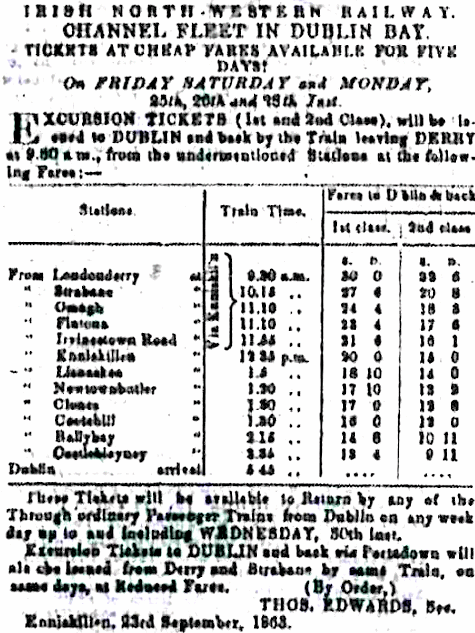 Excursion trains were also run at this time such as the special services that were operated to Dublin shown on the newspaper advertisement to the left. Excursion trains were also run at this time such as the special services that were operated to Dublin shown on the newspaper advertisement to the left.
During the winter of 1814 and again in 1855 ice caused severe damage to the Wooden Bridge, which, by 1858, led to a demand to build a new bridge across the River Foyle and to create a connecting line between the railways on both sides of the river at Derry. Agreement was reached and by 1859 work had started to construct a new double deck bridge of iron. Called the Carlisle Bridge (named after the Lord Lieutenant of Ireland, the Earl of Carlisle) it was constructed a little further to the south of the wooden bridge. The upper level of the new bridge, which was opened by the Earl of Carlisle (who travelled from Stranorlar by INWR train) on 24 September 1863, spanned the railway between the passenger and the goods facilities. The upper level was used by road vehicles and the lower level was provided with track and was for the exclusive use of rail vehicles which were hauled across by rope and capstan. This track was used by the successor to the L&CR, the Belfast & Northern Counties Railway (BNCR) so that they could move goods wagons into the city centre and docks from their Waterside terminus.
The INWR had also made a link to the Carlisle Bridge by 1863 to allow exchange of traffic with the BNCR.
From 1860 Moville on Lough Foyle had become a calling point for Atlantic liners to Canada and the USA. Passengers were brought down Lough Foyle by tender ships which sailed from the quays adjacent to Foyle Road station. The INWR ran special trains from Dundalk to Derry to connect with the Atlantic liners. These became known as the ‘Canadian Mail” and they ran from 1860 to 1869 on Fridays only. In 1863 the Canadian Mail left Dundalk at 10.55am arriving in Foyle Road at 3.00pm, which gave passengers more time to transfer to the tenders at the quay. Passengers on this Canadian Mail train were mainly emigrants, so they only paid a special half fare to Derry under the INWR. This traffic carrying emigrants to Canada and the USA would continue up to 1939 before it finally ceased.
Initially the ‘Canadian Mail’ had its own dedicated train and its mail carrying contract was worth £1,040 per year to the INWR. On 4 November 1864 the ‘Mail’ came into the station too fast and collided with an ‘up’ passenger train that was standing at the platform. Five people were injured. After the accident an instruction was given that the ‘Mail’ must go into a siding before entering the station and remain there until after the passenger train had left.
After January 1866 the mail was carried in a compartment of a carriage of a passenger train but guarded by a Post Office employee.
In 1867 the Londonderry Port and Harbour Commission (LP&HC), formed to develop new quays along the riverfront, had opened their lines along the quayside connecting the railway at Foyle Road and the Carlisle Bridge to the lines of the Londonderry and Lough Swilly Railway (L&LSR) near their Graving Dock station which had opened on 31 December 1863. The LP&HC lines used tramway style track as they passed over and along many public roads.
After 1869 a daily Day and Night Mail service to and from Dublin was introduced.
In 1868 Foyle Road station was described as being dilapidated and the INWR committed to improve it. In October 1868 a contract was awarded to Alex McElwee for the sum of £3,500 to carry out the works. As the new facilities were to occupy the site of the original station temporary arrangements had to be made. One of the goods sheds on the other side of the Carlisle Bridge was used as a temporary passenger station at this time.
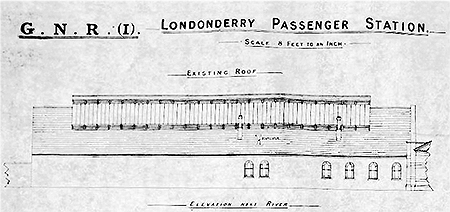 The new station facilities were ready by April 1870 and had cost £4,226. At the time of opening the new facilities were described as ‘magnificent”. These consisted of a lofty train shed 182 feet long and 72 feet wide in the Italianate style. The station frontage was in the form of a single-storey brick-built booking hall under a pitched roof set parallel to the entrance which was flanked by two rather squat Florentine Italianate towers, each side pierced by twin round-headed openings. A hipped, glazed awning sheltered the entrance. The building included both round-headed and rectangular window openings. The station was decorated with two turrets and included a circular ticket office. The new station facilities were ready by April 1870 and had cost £4,226. At the time of opening the new facilities were described as ‘magnificent”. These consisted of a lofty train shed 182 feet long and 72 feet wide in the Italianate style. The station frontage was in the form of a single-storey brick-built booking hall under a pitched roof set parallel to the entrance which was flanked by two rather squat Florentine Italianate towers, each side pierced by twin round-headed openings. A hipped, glazed awning sheltered the entrance. The building included both round-headed and rectangular window openings. The station was decorated with two turrets and included a circular ticket office.
There were two platforms which had three tracks between them. The platform that was beside Foyle Road (west side of the line) was the longer of the two and it extended beyond the train shed towards the Carlisle Bridge. A canopy extended along its length. The platform on the eastern side of the line was necessarily shorter due to the siding connection to the LPHC lines. The section that extended beyond the train shed was also provided with a canopy.
At the end of the eastern side platform there was a signal cabin (opened in 1869) which controlled the train movements within the station and the access to the LHC lines which connected into the station just to the south of the cabin. The 1870 map below shows the 1870 station facilities.
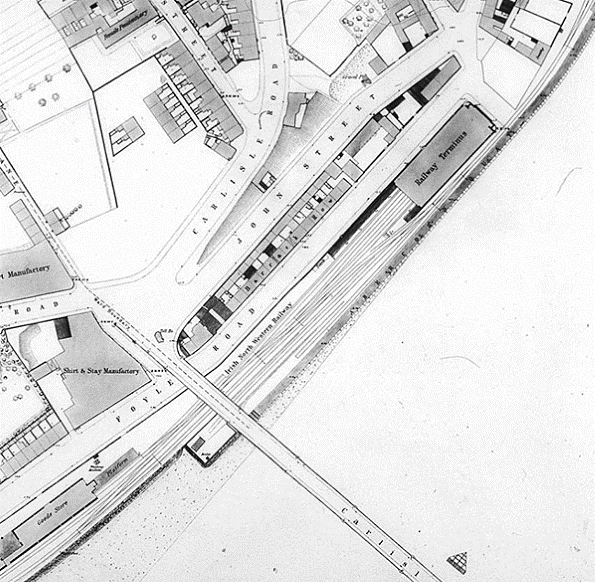
The new station facilities represented a significant improvement for the city of Derry/Londonderry. To deal with increased levels of goods traffic, the INWR opened extended goods facilities at the goods station south of the Carlisle Bridge in 1872. The BNCR had also opened a new improved Waterside station in 28 January 1875 and built their own City Goods station, just to the North of Foyle Road in Foyle Street, which opened on 1 May 1877.
On 1 January 1876 agreement was reached for the INWR to be taken over by the Northern Railway (Ireland) and in turn that company merged with the Ulster Railway to form the Great Northern Railway Ireland (GNRI) on 1 April 1876. The L&ER however remained a separate company until it was finally bought out by the GNRI in 1883.
In 1879 the signalling was improved and two cabins were provided. Both cabins were of a Railway Signalling Company design. The cabins were Londonderry North and Londonderry South. Londonderry North cabin was located a short distance to the south of the Carlisle Bridge and at the north end of the goods shed on the east side (river side) of the line. Londonderry South cabin was located almost a mile further south adjacent to the locomotive shed and the loco works of the L&ER.
A day mail train service carrying first class passengers and a Travelling Post Office (TPO) was introduced to Foyle Road on 1 April 1885. The TPO service ran to and from Portadown where it connected with mail trains to Belfast and Dublin.
On Friday 24 April 1885 the Prince of Wales (the future Edward VII) travelled from Foyle Road in the GNRI royal train. He departed from the station at 4.05pm and travelled to Newtownstewart to visit Baronscourt for the weekend.
In May 1885 the L&LSR re-gauged their line to 3ft and the LP&HC altered their line to mixed gauge.
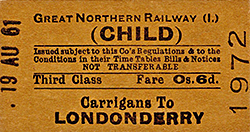 In 1887 the GNRI carried out improvements to Foyle Road station. The northern end of the train shed was converted into a concourse area with refreshment rooms, toilets and offices. Four arched windows, in a matching style to those on the 1870 frontage building, were made in the eastern wall of the train shed at its northern end for the refreshment rooms and offices. The conversion of the northern end of the train shed into a concourse area required the platforms to be extended southwards. As the eastern side platform could not be extended (due to the LP&HC connection) the solution was to create an island platform with two faces. The face on the west side of the island was for arrivals and that on the east for departures. Extending along the island platform beyond the train shed was a lengthy hipped, glazed awning bordered by a flat section with shallow, serrated valances, the whole being carried on elaborate columns with intricately detailed spandrels. In 1887 the GNRI carried out improvements to Foyle Road station. The northern end of the train shed was converted into a concourse area with refreshment rooms, toilets and offices. Four arched windows, in a matching style to those on the 1870 frontage building, were made in the eastern wall of the train shed at its northern end for the refreshment rooms and offices. The conversion of the northern end of the train shed into a concourse area required the platforms to be extended southwards. As the eastern side platform could not be extended (due to the LP&HC connection) the solution was to create an island platform with two faces. The face on the west side of the island was for arrivals and that on the east for departures. Extending along the island platform beyond the train shed was a lengthy hipped, glazed awning bordered by a flat section with shallow, serrated valances, the whole being carried on elaborate columns with intricately detailed spandrels.
This led to an improved train service and in August 1887 there were 5 arrivals and departures to Dundalk mainly via Enniskillen. There was a workman’s train in the morning from Omagh returning in the evening. The evening mail train to and from Dublin ran 7 days a week, but the only Sunday service was a summer service to Bundoran in the morning with a return working in the afternoon.
The December 1895 timetable showed eight passenger arrivals and departures Monday-to-Saturday with a train in each direction on Sundays. Destinations served included Belfast, Enniskillen and Dundalk with a local working to Strabane.
On Saturday 4 September 1897 there was another royal visitor to Foyle Road. On this occasion the Duke of York (the future George V), whilst on a visit to Ireland, travelled from Newtownstewart and arrived in Derry/Londonderry at about 1.00pm.
|

 Home
Page
Home
Page

 Home
Page
Home
Page